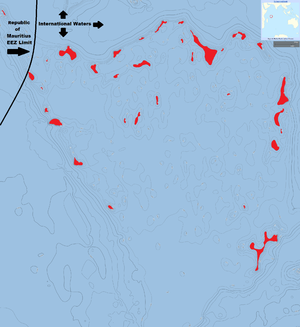Saya de Malha Bank
This article has multiple issues. Please help improve it or discuss these issues on the talk page. (Learn how and when to remove these template messages)
|

Saya de Malha Bank is a large ocean bank mostly within international waters with several areas being only 10 meters or less below the surface of the water. As such it has been suggested as a candidate for building artificial islands.
History
Saya de Malha Bank was named by Portuguese explorers 500 years ago. Its name means 'Mesh Skirt' and is a reference to the seagrass encountered growing in the relatively shallow waters. It was first surveyed by a Royal Navy expedition under Captain Robert Moresby in 1838.
From 1997 until 2002 the Saya de Malha Bank was the site of an attempt to create an artificial island by Prof. Wolf Hilbertz and Dr. Thomas J. Goreau. By using an electric charge through a steel structure minerals in ocean water were coaxed to accrete to the surface of the metal. Two expeditions were carried out to bring this plan to fruition. A third expedition to actually build the artificial island above sea level was planned but there is no evidence it was ever carried out. Once the island was finished the two men intended to name it Autopia and declare it an independent nation.
In 2019 the Principality of Artland claimed to have annexed the ocean bank with the intent of building an island resort 'dedicated to art and eco-sustainable tourism'.
Early 2021 saw the Mozanian Empire lay claim to two shallow areas in the western part of the bank while the Artificial Island Project selected Saya de Malha Bank as its area of focus for future construction. Both groups are cooperating with each other.
Geography
Saya de Malha Bank is theorized to be the result of the messy continental break up of the island of Madagascar and the sub-continent of India which resulted in increased volcanism and pieces of continental plate being scattered in the mid-Indian Ocean. Depths vary on the sunken plateau from ~8 meters to ~200 meters deep. The bank is composed of basalt rocks overlaid with limestone. The limestone is the result of ancient coral reefs.
Climate
Being near the Equator the ocean bank enjoys a tropical climate. Cyclones can reach the bank but for the most part it is located out of the direct path of most storms.
Shipping Hazard
Due to the shallow water the great majority of ocean-going vessels take pains to avoid Saya de Malha Bank. Despite this the bank is located near several major shipping routes.
This article has not been added to any content categories. Please help out by adding categories to it so that it can be listed with similar articles. (July 2023) |